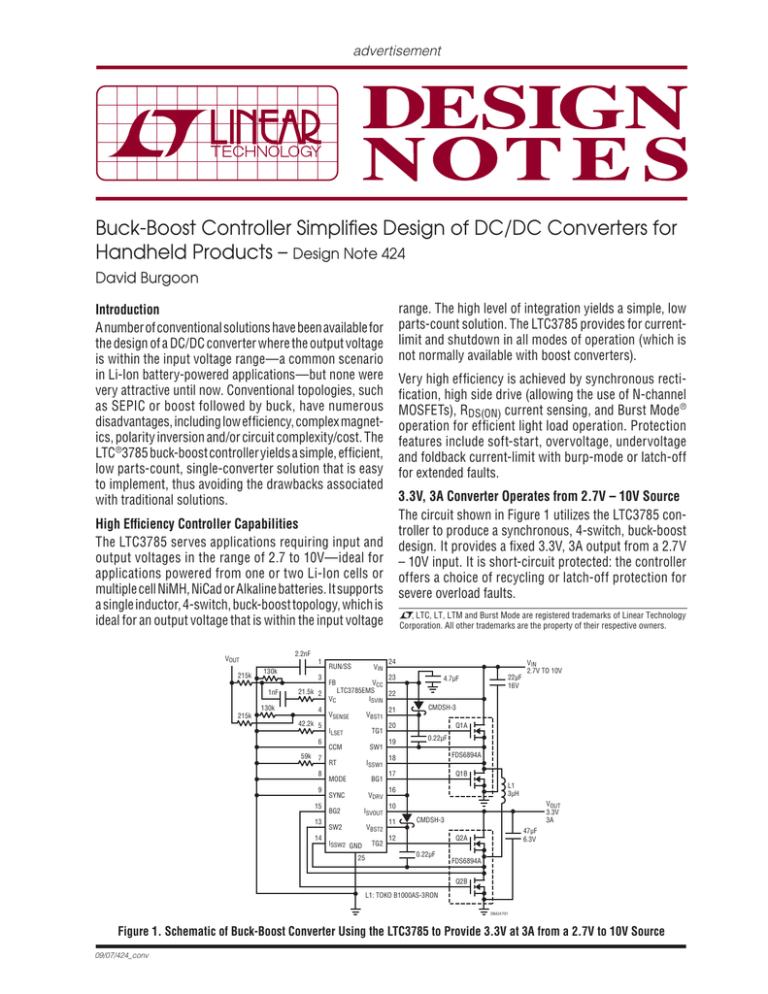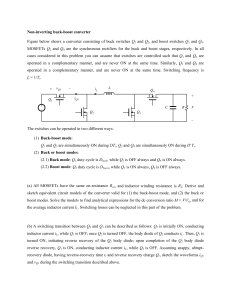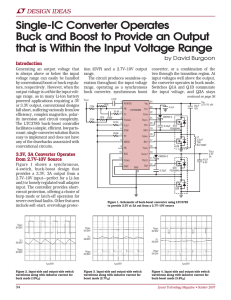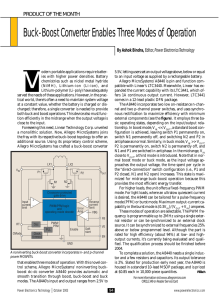Buck-Boost Controller Simplifies Design of DC/DC Converters for
advertisement

advertisement Buck-Boost Controller Simplifies Design of DC/DC Converters for Handheld Products – Design Note 424 David Burgoon range. The high level of integration yields a simple, low parts-count solution. The LTC3785 provides for currentlimit and shutdown in all modes of operation (which is not normally available with boost converters). Introduction A number of conventional solutions have been available for the design of a DC/DC converter where the output voltage is within the input voltage range—a common scenario in Li-Ion battery-powered applications—but none were very attractive until now. Conventional topologies, such as SEPIC or boost followed by buck, have numerous disadvantages, including low efficiency, complex magnetics, polarity inversion and/or circuit complexity/cost. The LTC®3785 buck-boost controller yields a simple, efficient, low parts-count, single-converter solution that is easy to implement, thus avoiding the drawbacks associated with traditional solutions. Very high efficiency is achieved by synchronous rectification, high side drive (allowing the use of N-channel MOSFETs), RDS(ON) current sensing, and Burst Mode ® operation for efficient light load operation. Protection features include soft-start, overvoltage, undervoltage and foldback current-limit with burp-mode or latch-off for extended faults. 3.3V, 3A Converter Operates from 2.7V – 10V Source The circuit shown in Figure 1 utilizes the LTC3785 controller to produce a synchronous, 4-switch, buck-boost design. It provides a fixed 3.3V, 3A output from a 2.7V – 10V input. It is short-circuit protected: the controller offers a choice of recycling or latch-off protection for severe overload faults. High Efficiency Controller Capabilities The LTC3785 serves applications requiring input and output voltages in the range of 2.7 to 10V—ideal for applications powered from one or two Li-Ion cells or multiple cell NiMH, NiCad or Alkaline batteries. It supports a single inductor, 4-switch, buck-boost topology, which is ideal for an output voltage that is within the input voltage 2.2nF VOUT 215k , LTC, LT, LTM and Burst Mode are registered trademarks of Linear Technology Corporation. All other trademarks are the property of their respective owners. 1 130k 1nF 3 21.5k 2 130k 4 215k 42.2k 5 6 59k 7 8 9 15 13 14 RUN/SS FB VC VIN 24 23 4.7μF VCC LTC3785EMS 22 ISVIN VSENSE VBST1 ILSET TG1 CCM SW1 RT ISSW1 BG1 MODE VDRV SYNC ISVOUT BG2 VBST2 SW2 ISSW2 GND 25 TG2 21 VIN 2.7V TO 10V CMDSH-3 Q1A 20 19 22μF 16V 0.22μF FDS6894A 18 Q1B 17 L1 3μH 16 VOUT 3.3V 3A 10 11 CMDSH-3 12 47μF 6.3V Q2A 0.22μF FDS6894A Q2B L1: TOKO B1000AS-3RON DN424 F01 Figure 1. Schematic of Buck-Boost Converter Using the LTC3785 to Provide 3.3V at 3A from a 2.7V to 10V Source 09/07/424_conv The circuit produces seamless operation throughout the entire input voltage range, operating as a synchronous buck converter, synchronous boost converter, or a combination of the two through the transition region. At input voltages well above the output, the converter operates in buck mode. Switches Q1A and Q1B commutate the input voltage, and Q2A stays on, connecting L1 to the output. As the input voltage is reduced and approaches the regulated output voltage, the converter approaches maximum duty cycle on the input (buck) side of the bridge, and the output (boost) side of the bridge starts to switch, thus entering the buck-boost or 4-switch region of operation. As the input is reduced further, the converter enters the boost region at the minimum boost duty cycle. Switch Q1A stays on, connecting the inductor to the input while switches Q2A and Q2B commutate the output side of the inductor between the output capacitor and ground. In boost mode, this converter has the ability to limit input current, and also to shut down and disconnect the source from the output—two desirable features that a conventional boost converter cannot provide. Figures 2, 3 and 4 show input side and output side switch waveforms along with inductor current for buck (10V input), boost (2.7V input) and buck-boost (3.8V input) modes of operation. VSW1 5V/DIV IL1 2A/DIV VSW2 5V/DIV 1μs/DIV DN424 F02 Figure 2. Input Side and Output Side Switch Waveforms Along with Inductor Current for Buck (10V Input) Mode Operation for the Circuit in Figure 1 VSW1 5V/DIV IL1 2A/DIV VSW2 5V/DIV 1μs/DIV Figure 4. Input Side and Output Side Switch Waveforms Along with Inductor Current for Buck-Boost (3.8V Input) Mode Operation for the Circuit of Figure 1 95% Efficiency Figure 5 shows efficiency curves for both normal (not forced continuous conduction) and Burst Mode operation. Exceptional efficiency of 95% is achieved at typical loads, resulting from sophisticated controller features including high side drivers and RDS(ON) current sensing. Even higher efficiencies are possible by using a larger ferrite inductor. This circuit easily fits in 0.6in2 with components on both sides of the board. The curves show how Burst Mode operation improves efficiency at extremely light loads—an important determinant of battery run time. Conclusion The LTC3785 is the latest addition to our class of buckboost converters developed by Linear Technology to satisfy the requirements of battery-powered applications, specifically those requiring an output voltage that is within the input voltage range. A topology based on the LTC3785 controller overcomes the deficiencies of conventional designs. It is elegant in its simplicity, high in efficiency, and requires only a small number of inexpensive external components. 100 90 EFFICIENCY (%) 80 VSW1 5V/DIV IL1 2A/DIV DN424 F04 Burst Mode OPERATION 70 VIN 60 50 40 30 2.7V 3.0V 4.2V 20 VSW2 5V/DIV 10 0.001 1μs/DIV DN424 F03 Figure 3. Input Side and Output Side Switch Waveforms Along with Inductor Current for Boost (2.7V Input) Mode Operation for the Circuit in Figure 1 0.01 0.1 1 OUTPUT CURRENT (A) 10 DN424 F05 Figure 5. Efficiency in Normal and Burst Mode Operation for the Circuit in Figure 1 Data Sheet Download For applications help, call (408) 432-1900, Ext. 3420 www.linear.com Linear Technology Corporation dn424f_conv LT/TP 0907 305K • PRINTED IN THE USA FAX: (408) 434-0507 ● www.linear.com © LINEAR TECHNOLOGY CORPORATION 2007 1630 McCarthy Blvd., Milpitas, CA 95035-7417 (408) 432-1900 ●





